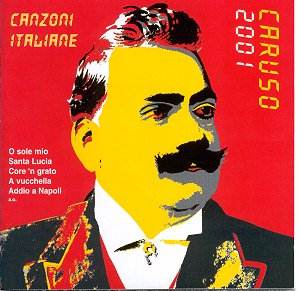 Composer: Enrico Caruso
Composer: Enrico Caruso
Works: Italian Songs: Vieni sul mar, O sole mio, Tu can nun chiagne, Santa Lucia, Pecche, L’Alba separa luce l’ombra, Fenesta che lucive, Mamma mia, Musica proibita, Core ‘ngrato, Luna d’estate, Ideale, A Vucchela, Vaghissima sembianza, Tarantella sincera, Senza nisciuno, Addio a Napoli
Performers: Vienna Radio Symphony Orchestra, Gottfried Rabl (conductor)
Recording: Original 78s recorded 1908-1921, orchestrated tracks recorded January 2001
Label: BMG Classics 74321 82569 2
Enrico Caruso, often hailed as the quintessential tenor of the early 20th century, remains a towering figure in the pantheon of classical music. His recordings, meticulously resurrected through modern technology, continue to resonate with both historical significance and emotional depth. This compilation, “Caruso 2001 – Tenor of the Century,” offers a rich tapestry of Italian songs that exemplify the vocal prowess and stylistic nuances that defined his artistry. The selections, ranging from the exuberant “O sole mio” to the poignant “Addio a Napoli,” reflect both the popular and operatic traditions that Caruso so effortlessly bridged.
The performance, under the baton of Gottfried Rabl, is marked by a careful balancing of Caruso’s voice with the orchestral accompaniment. The Vienna Radio Symphony Orchestra’s playing is big and beefy, yet not overly opulent, allowing Caruso’s distinctive timbre to shine through. Rabl’s arrangements, which incorporate elements of the havanaise and the Neapolitan serenade, provide a lush backdrop that enhances the emotional weight of the songs. Particularly notable is the track “Musica proibita,” where Peter Matzka’s solo violin weaves a delicate line that complements Caruso’s rich baritone. The orchestration feels well-integrated, showcasing Caruso’s vocal capabilities without overshadowing him.
Technically, the sound quality is impressive for its time, with the audio engineering adeptly stripping away the sonic limitations of the original 78s. The remastering process has preserved the warmth and character of Caruso’s voice while enhancing clarity. In “Luna d’estate,” for instance, we encounter a moment that captures the tenor’s ability to convey both freshness and nostalgia, a rare combination that speaks to his artistic range. Comparatively, while other iconic recordings of Caruso’s work exhibit a more straightforward approach, this compilation embraces the lushness of orchestral color that aligns closely with the emotional core of the songs.
Caruso’s interpretative choices throughout the collection reveal a nuanced understanding of the material. His delivery in “Senza nisciuno” is operatic in its grandeur, echoing the dramatic flair reminiscent of Puccini, while “Core ‘ngrato” showcases a tenderness that belies its more sentimental reputation. The emotional spectrum he traverses is further highlighted by the occasional silliness found in tracks like “Tarantella sincera,” underscoring Caruso’s versatility as a performer who could transcend the boundaries of high art and popular music.
This collection stands as a testament not only to Caruso’s immortal voice but also to the artistry that continues to inspire generations. The thoughtful curation by BMG Classics and the innovative engineering techniques breathe new life into these historical recordings, ensuring that Caruso’s legacy remains vibrant. The detailed documentation accompanying the release enriches the listener’s experience, offering insights into Caruso’s life and the historical context of the recordings.
For those who appreciate the nuances of early 20th-century vocal artistry, this collection is an essential acquisition. The combination of historical importance, technical achievement, and emotional resonance makes “Caruso 2001 – Tenor of the Century” a compelling listening experience that is likely to captivate both longtime fans and new admirers alike.



